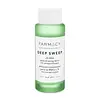What's inside
What's inside
 Key Ingredients
Key Ingredients

 Benefits
Benefits

 Concerns
Concerns

 Ingredients Side-by-side
Ingredients Side-by-side

Water
Skin ConditioningArginine
MaskingSalicylic Acid
MaskingLactobacillus/Papaya Fruit Ferment Extract
AbrasiveMoringa Oleifera Leaf Water
Skin ConditioningMoringa Oleifera Seed Extract
Skin ConditioningEucalyptus Globulus Leaf Water
MaskingChlorella Ferment
Skin ConditioningPaeonia Suffruticosa Root Extract
Skin ProtectingScutellaria Baicalensis Root Extract
AstringentLactic Acid
BufferingGlycerin
HumectantButylene Glycol
HumectantXylitylglucoside
HumectantAnhydroxylitol
HumectantXylitol
HumectantLeuconostoc/Radish Root Ferment Filtrate
AntimicrobialGluconolactone
Skin ConditioningMaltodextrin
AbsorbentGlucose
HumectantPotassium Sorbate
PreservativeSodium Benzoate
MaskingWater, Arginine, Salicylic Acid, Lactobacillus/Papaya Fruit Ferment Extract, Moringa Oleifera Leaf Water, Moringa Oleifera Seed Extract, Eucalyptus Globulus Leaf Water, Chlorella Ferment, Paeonia Suffruticosa Root Extract, Scutellaria Baicalensis Root Extract, Lactic Acid, Glycerin, Butylene Glycol, Xylitylglucoside, Anhydroxylitol, Xylitol, Leuconostoc/Radish Root Ferment Filtrate, Gluconolactone, Maltodextrin, Glucose, Potassium Sorbate, Sodium Benzoate
Aloe Barbadensis Leaf Juice
Skin ConditioningRosa Damascena Flower Water
MaskingGlycerin
HumectantBetaine
Humectant1,2-Hexanediol
Skin ConditioningPanthenol
Skin ConditioningAscorbic Acid
AntioxidantTocopheryl Acetate
AntioxidantSodium Hyaluronate
HumectantSodium Benzoate
MaskingPanax Ginseng Root Extract
EmollientCamellia Sinensis Leaf Extract
AntimicrobialAllantoin
Skin ConditioningHamamelis Virginiana Water
AstringentCucumis Sativus Fruit Extract
EmollientLactic Acid
BufferingChamomilla Recutita Flower Extract
MaskingCitrus Paradisi Seed Extract
MaskingPolyglyceryl-4 Oleyl Ether
EmulsifyingOleic Acid
EmollientPelargonium Graveolens Flower Oil
MaskingCitrus Aurantium Dulcis Peel Oil Expressed
PerfumingAloe Barbadensis Leaf Juice, Rosa Damascena Flower Water, Glycerin, Betaine, 1,2-Hexanediol, Panthenol, Ascorbic Acid, Tocopheryl Acetate, Sodium Hyaluronate, Sodium Benzoate, Panax Ginseng Root Extract, Camellia Sinensis Leaf Extract, Allantoin, Hamamelis Virginiana Water, Cucumis Sativus Fruit Extract, Lactic Acid, Chamomilla Recutita Flower Extract, Citrus Paradisi Seed Extract, Polyglyceryl-4 Oleyl Ether, Oleic Acid, Pelargonium Graveolens Flower Oil, Citrus Aurantium Dulcis Peel Oil Expressed
 Reviews
Reviews

Ingredients Explained
These ingredients are found in both products.
Ingredients higher up in an ingredient list are typically present in a larger amount.
Glycerin is already naturally found in your skin. It helps moisturize and protect your skin.
A study from 2016 found glycerin to be more effective as a humectant than AHAs and hyaluronic acid.
As a humectant, it helps the skin stay hydrated by pulling moisture to your skin. The low molecular weight of glycerin allows it to pull moisture into the deeper layers of your skin.
Hydrated skin improves your skin barrier; Your skin barrier helps protect against irritants and bacteria.
Glycerin has also been found to have antimicrobial and antiviral properties. Due to these properties, glycerin is often used in wound and burn treatments.
In cosmetics, glycerin is usually derived from plants such as soybean or palm. However, it can also be sourced from animals, such as tallow or animal fat.
This ingredient is organic, colorless, odorless, and non-toxic.
Glycerin is the name for this ingredient in American English. British English uses Glycerol/Glycerine.
Learn more about GlycerinLactic Acid is another well-loved alpha hydroxy acid (AHA). It is gentler than glycolic acid but still highly effective.
Its main role is to exfoliate the surface of the skin by loosening the “glue” that holds dead skin cells together. Shedding those old cells leads to smoother, softer, and more even-toned skin.
Because lactic acid molecules are larger than glycolic acid, they don’t penetrate as deeply. This means they’re less likely to sting or irritate, making it a great choice for beginners or those with sensitive skin.
Like glycolic acid, it can:
Lactic acid also acts as a humectant (like hyaluronic acid). It can draw water into the skin to improve hydration and also plays a role in the skin's natural moisturizing factor (NMF) in the form of sodium lactate.
Studies show it can boost ceramide production to strengthen the skin barrier and even help balance the skin’s microbiome.
To get results, choose products with a pH between 3-4.
Lower strengths (5-12%) focus on surface exfoliation; higher strengths (12% and up) can reach deeper in the dermis (deeper, supportive layer) to improve skin texture and firmness over time.
Though it was originally derived from milk, most modern lactic acid used in skincare is vegan. It is made through non-dairy fermentation to create a bio-identical and stable form suitable for all formulations.
When lactic acid shows up near the end of an ingredient list, it usually means the brand added just a tiny amount to adjust the product’s pH.
Legend has it that Cleopatra used to bathe in sour milk to help reduce wrinkles.
Lactic acid is truly a gentle multitasker: it exfoliates, hydrates, strengthens, and brightens. It's a great ingredient for giving your skin a smooth, glowing, and healthy look without the harshness of stronger acids.
Read more about some other popular AHA's here:
Learn more about Lactic AcidSodium Benzoate is a preservative. It's used in both cosmetic and food products to inhibit the growth of mold and bacteria. It is typically produced synthetically.
Both the US FDA and EU Health Committee have approved the use of sodium benzoate. In the US, levels of 0.1% (of the total product) are allowed.
Sodium benzoate works as a preservative by inhibiting the growth of bacteria inside of cells. It prevents the cell from fermenting a type of sugar using an enzyme called phosphofructokinase.
It is the salt of benzoic acid. Foods containing sodium benzoate include soda, salad dressings, condiments, fruit juices, wines, and snack foods.
Studies for using ascorbic acid and sodium benzoate in cosmetics are lacking, especially in skincare routines with multiple steps.
We always recommend speaking with a professional, such as a dermatologist, if you have any concerns.
Learn more about Sodium Benzoate